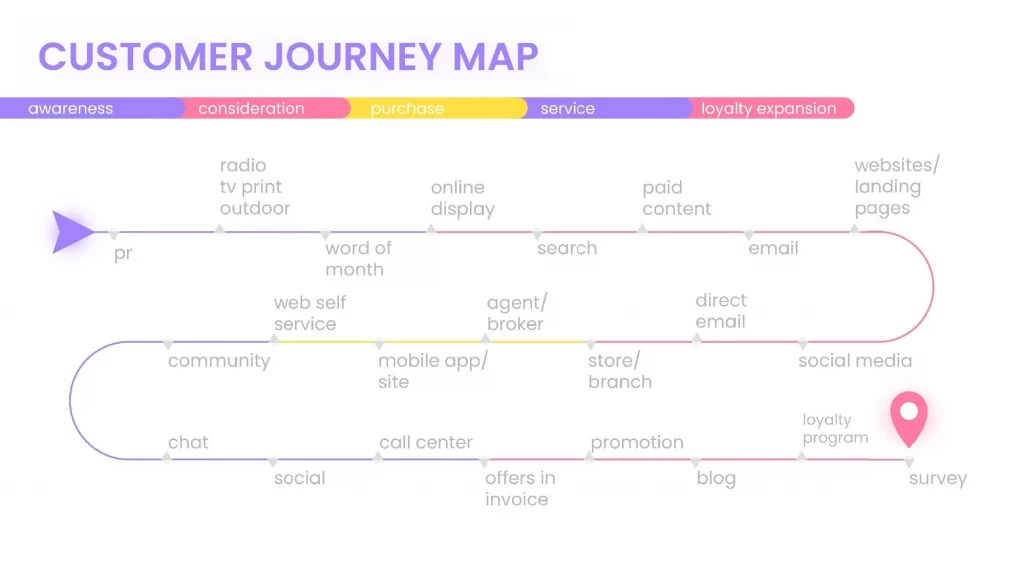Customer Journey: Build it with support from Marketing Automation

Every purchasing process can be depicted as a journey. Analyzing and optimizing this process can help you win more customers and make your business more stable. How can marketing automation help you with this? Let’s find out!
Usually, a customer journey starts when your customer acknowledges they have a problem or a need. In the next stages, they look for solutions and compare available options. Lastly, the order is placed, and the journey is almost complete (we’re saying almost because there’s also the retention stage, and if everything goes well, it never really ends).
At each of these stages, marketing automation can help you streamline your work and make it more effective. So, we will break down the customer journey and see how it can be improved using MA.
What’s the goal of a customer journey (CJ)?
The shortest answer is the improvement of your customers’ experiences. If you have a full view of the purchasing process in your store, along with everything that happens along the way, you can see what should be changed, removed, or improved in order to streamline the process.
Now, a streamlined and easy purchasing process is a quick way to win your customers’ satisfaction. Indirectly, it can help you get more customers and some positive reviews of your store. Sounds like it’s worth it, doesn’t it?
There are several elements every customer journey should have.
What should be in your customer journey?
There is no one fixed way of creating customer journeys. They differ slightly depending on the company, the product/service, and even the industry. Typically, there are five to seven stages of the customer journey (we will discuss them in a moment), but within these stages, there are several elements you need to include to make your CJ complete.
THE PURCHASING PROCESS
That’s the foundation of every customer journey. Try to depict the whole process as a list of subsequent actions and stages, just like in this example:
Your customer journey should answer the following questions:
- Where can customers find out about my offer?
- What sales channels do I offer?
- What steps the customer needs to complete in order to get my product?
Try to imagine a customer who’s never heard about your business going through this process. Note down every step, including how they open your website or visit your store, put products in the cart, pay online, track the parcel, and open the box.
The more detailed your CJ is, the better. It will allow you to dissect every element and see what can be improved. Can you deliver your parcels faster? Can you secure the product better? Are there any popular payment methods that are missing from your store? These are all examples of questions you should be asking (and answering!) when analyzing the customer journey.
How can marketing automation help you?
With scenarios of marketing automation, you can decide what your company should do at each stage of the purchasing process.
CUSTOMER PERSONAS
These are representations of your typical customers. The goal is to understand who is your customer and why they are buying from you. If you run a large retail company, you will probably have many different personas. It’s usually sufficient to analyze the major types just the get the general picture. After all, even if you’re selling flowers and teenagers aren’t your major target audience, from time to time, there may be a teenager who wants to buy some flowers, right? Keep your personas real and useful.
How can marketing automation help you?
Our customer data platform will help you understand what kind of people buy from you. It’s a good starting point for creating customer personas! We also have a persona creator to help you with the whole process.
TOUCHPOINTS
They are also immensely important! In short, touchpoints are means and moments of interaction between your company and your customers. Maybe a few examples to show you what touchpoints are about:
- When a customer is browsing Google, and they see and click your ad, that’s a touchpoint.
- When a customer goes to the external payment gate, that’s a touchpoint.
- When a customer sends a query to your customer support team, that’s a touchpoint.
Touchpoints help you understand when and how customers can interact/communicate with your business. The goal is the same – to improve every such element.
How can marketing automation help you?
Depending on the touchpoint, you can use email marketing, SMS marketing, or push notifications to stay in touch with your customers.
These are three basic elements of the customer journey. However, some companies want to do something even more detailed, and they add more elements, such as:
- Emotions: Some stores try to map emotions that accompany customers at each stage of the sales process. They can also add emotions that they WANT TO trigger with their offer (e.g., at first customer is frustrated, but once they find our solution, they feel relieved).
- Pain points: These are quite important, actually. Pain points answer the question, “Why?” Why did the customer look for our product? Why should they choose our solution to their problem? Finding answers to these questions can help you improve your sales process in its early stages.
- Solutions: They answer the question, “How?” How will you help your customers? How will you answer queries you receive? How will you deliver the product? Etc. A good list of solutions can win you many satisfied customers.
5 stages of a customer journey
Like we mentioned earlier, these are not definite. Customer journeys differ as well as their stages. But in general, there are five rather common stages:
STAGE 1: AWARENESS
Here, the consumer becomes aware of their need or their problem. For example, you discover you have ants in your house. You immediately become aware of the need to hire a pest control company. That’s this stage. In the same stage, the customer starts looking for a solution, and they bump into your offer. What’s next?
How can marketing automation help you?
Integrate marketing automation with Google Ads to make your offer more visible. Recommendation frames showing just the right product are also useful.
STAGE 2: CONSIDERATION
The customer now has several options to choose from. If the pain point is severe, they frequently pick the first option they see. If not, they can devote some time to analyze available offers and pricing plans. The more expensive the purchase, the consideration stage takes longer.
How can marketing automation help you?
Among many other options, content automation can help your customers pick the best option.
STAGE 3: PURCHASE
The consumer makes the purchase or places the order. The decision is made, and the customer is now waiting for the technician to arrive, for the parcel to come, for the car to be delivered, etc.
How can marketing automation help you?
Abandoned carts are a big problem. You can use MA to respond to abandoned processes and encourage more people to buy.
STAGE 4: EXPERIENCE
The customer now has the product/service. They are using it and slowly building their opinion about it. Was the treatment effective? Is the car comfortable enough? Is the new computer as fast as promised? Do I like the color of this bike? At this stage, customers can be contacted by the company to encourage brand loyalty. And that’s the last stage.
How can marketing automation help you?
You can ask your customers about their experiences through NPS surveys.
STAGE 5: RETENTION
The goal is to keep the customer satisfied and loyal to the company. If all the previous stages went well, that’s very likely. Let’s go back to our pest control example. Suppose the technician arrived on time, they did a good job (ants are now gone), and the price was reasonable. Now, half a year later, you have another pest problem – there are cockroaches in your kitchen. Will you call the same guy or look for someone else? Provided you still have the number or remember the company’s name, you will likely call the same person. That’s what retention is about. And that’s what we meant in the introduction to this post – with the retention stage, the customer journey can never really end.
How can marketing automation help you?
Use our loyalty tools to keep customers close to your brand for many months to come!
Wrapping up
As you can see, marketing automation can help you at every stage of the customer journey. With this technology, everything is faster, easier, and more accurate. Would you like to give MA a shot? Just send this short form and start a free trial of our system!




